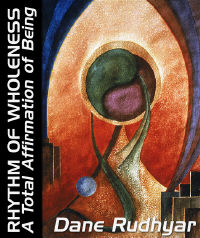 |
| Home | Bio | Art | Music | Literature | Civilization & Culture | Philosophy of Wholeness | Theosophy & Spirituality | Astrology |

RHYTHM OF WHOLENESS A Total Affirmation of Being by Dane Rudhyar, 1983 CONTENTS PROLOGUE PART ONE The Philosophy of Operative Wholeness 1. Prelude to a New Interpretation of Reality 2. The Search for Spiritual Security: The One, the Whole, and Wholeness Page 1 Page 2 Page 3 Page 4 Page 5 Page 6 3. The Movement of Wholeness PART TWO The Cycle of Being 4. The Structure of the Cycle of Being 5. The Four Crucial Phases of the Cycle of Being 6. The Inevitability of Success and Failure 7. Spirit and Mind PART THREE The Cycle of Man 8. Constitution of Man - The Physical and Psychic Bodies 9. Constitution of Man - The Spiritual Entity and the Higher Mind 10. The Structure and Transformation of the Total Person 11. The Cyclic Process of Spiritual Embodiment PART FOUR In The Spirit of Wholeness 12. The Principle of Holarchy and the Interplay of Horizontal and Vertical Relationships 13. Transpersonal Activity versus Mediumship 14. Rites of Passage EPILOGUE |

CHAPTER TWO
The Search for Spiritual Security: The One, the Whole, and Wholeness - 6 In the second section of this chapter, I attempted to present a symbolic picture of reality which to some extent would solve the conundrum involved in all monistic metaphysics — the paradox of the concept of a timeless, changeless "One" formulated by human beings for whom change and ever-present motion is the basic and primary experience. In this picture, reality has many levels; at the center, all that has existed, is existing, and will exist "is" in a changeless, motionless state of being. The more distant any level of reality is from the central core, the more complex the forms taken by the movement of becoming — and the greater the confusion and "ignorance" of what is in this process of becoming, that is, of "the Many." The pure monist philosopher and the mystic may accept the concept of the cycle — the "wheel" of existence, samsara — but they apply it only to the levels of becoming; for only there are they willing to accept the reality of change, though this change would appear to be illusion to the changeless consciousness of "the One." Thus the changeless stance of "the One" somehow — ineffably and alogically — is both essentially different from the cyclic movement of universal becoming and mysteriously pervading it. The two are absolutely different and cannot be related in any way, because "the One" is beyond any possibility or need for relation; otherwise It would not be "absolute." From the point of view of the mind of a truly individualized person, this is really an impossible situation. How can everything be changelessly "now" and yet the individual human being have "free will" — that is, the ability to decide between alternative futures? This makes no sense whatsoever. All any philosopher ever has been able to say is that "somehow" this is what is. Thus it is a situation in which the individual, aware of his or her essential selfhood and the problems it brings, must admit logical defeat: Credo quia absurdum (I believe because it is absurd). Such a picture can bring a sense of spiritual security only through an attitude of total denial. It is not the kind of denial of which the Bhagavad Gita speaks when Krishna asks of his disciple Arjuna that the latter, while acting, leave to him the results of action, thus any concern with them. In his aspect as the Supreme Being, Krishna already has determined the action. There is action; all Krishna asks of the human being is not to be concerned with its results, but simply to perform the works required by his fundamental nature — that is, what he is born for, his dharma. In the philosophy presented in this book the essential factor in a human life is the performance of dharma. The picture of being that the philosophy outlines is meant to bring to the performer: (1) a vast, cosmic, totally ordered picture of the meaning of the dharma of Man, archetypally considered; and (2) a full grasp of the cyclic interactions of all the constituents of an individual human whole (detailed in Part Three) in relation to humanity-as-a-whole, the planet earth, and by implication the whole cycle of our universe as-we are able to perceive it. This picture does not negate anything. It accepts everything — in its proper place and according to its essential function. It is an unceasing affirmation of being. Even when the concept of the "inevitability of failure" is introduced, it is presented in an ultimately affirmative and positive way, for it is shown to be the polarizing factor of "divine Compassion" — the essential nature of spirit, which itself is simply an aspect of the omnipresent polarity of being. Because this aspect is focused in a particular way during the phase of the universal cycle of being which witnesses the development of archetypal Man, the crucial but inherently magnificent characteristic of what "being human" means is presented in a dramatic, and, even more important, a ritualistic manner. Such a presentation may not appeal to weak minds as providing the "spiritual security" for which they yearn; but this philosophy of wholeness is not meant to appeal to weakness. A total affirmation of being under any and all conditions needs an epic quality: Man wrestles with change. His glory is that he can be defeated temporarily, for this alone makes victory possible. Victory, human style, is never achieved unless the full meaning and implications of what one has fought for are understood. The whole situation has to be understood. In that understanding, Wholeness is revealed. From Wholeness there is no escape. All concepts of absolutes are escapes. Immobility is an escape from change. Now — the "eternal Now" of popularized mysticism — is an escape from the performance of dharma, for dharma can be illumined only by the revelation of meaning and purpose. Wholeness is dynamic. It is always in the making and remaking; motion is unceasing. Yet Wholeness is also the cyclicity of motion, and the Movement of Wholeness is the cycle of being. The one spiritual injunction, however formulated, is always, "Walk on!" By permission of Leyla Rudhyar Hill Copyright © 1983 by Dane Rudhyar All Rights Reserved.  Web design and all data, text and graphics appearing on this site are protected by US and International Copyright and are not to be reproduced, distributed, circulated, offered for sale, or given away, in any form, by any means, electronic or conventional. See Notices for full copyright statement and conditions of use. Web design copyright © 2000-2004 by Michael R. Meyer. All Rights Reserved. |
 |